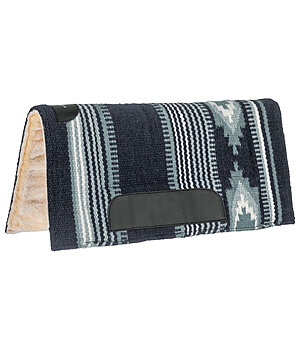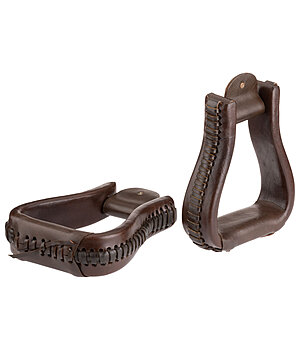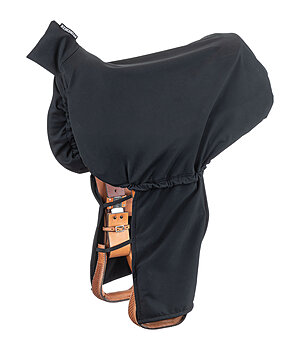Western saddle accessories – what do I need to know?
You have found the optimal Western saddle for your horse. Now it’s time for the accessories, which should also be selected with great attention to detail and with constant consideration for the horse’s well-being.

The quality of the Western pad and the correct shape of the Western girth have an effect on the fit of the saddle and on keeping the horse healthy, thus actively contributing to the comfort and better acceptance of the saddle.
What accessories do I need for my Western saddle?
Obligatory accessories for the Western saddle:
- Western saddle pad or Western blanket with liner/pad.
- Western saddle girth with tie strap and off billet
Other optional accessories:
Western saddle pads – not only beautiful to look at
Investing in a high-quality Western pad is worthwhile for both horse and rider. While laymen often think that the Western pad with its often elaborate design only lies on the horse for visual purposes, experienced Western riders know that the pad fulfills valuable functions and creates important conditions for a harmonious horse-rider pair:
1. Padding of the saddle on the back for more wearing comfort.
2. Absorption of pressure peaks caused by the rider’s movements
3. Targeted transmission of the rider’s weight aids
4. Compensation of slight fitting issues of the saddle
5. To protect the saddle from leather-damaging horse sweat
6. To allow air circulation and sweat absorption during work while avoiding heat accumulation.

But with the variety of Western pads available – how do you choose the best pad for your horse?
At this point you should first ask yourself the following questions:
How big does the Western pad have to be?
The size of the pad should be based on the size of the saddle. A Western pad should be 10 cm longer than the Western saddle so that there is 5 cm space between the outer edge of the pad and the saddle at the front and at the back.
Special attention should be paid to the rear position of the Western pad. If the pad is too long, it can restrict the horse’s movement by „wedging“ the pad to the hip bone. In addition, hair breakage or chafing can also be a consequence of too long Western pads.
How thick does a Western pad have to be?
The average thickness of a Western pad is between 2 and 4 cm. The choice of thickness should take into account both the saddle and the intended use. Thicker pads are mostly used for longer trail rides or daily training, but also for cattle disciplines. The better the fit of the saddle, the thinner the pad can be, but pads under 2 cm are only suitable as underlay, e.g. when using a show blanket.
Correction Pads
So-called correction pads are particularly well suited to compensate for problems in the saddle area. These pads are equipped with various inserts in which you can compensate for saddle fit problems or temporary muscle deficits with inserts – usually made of chloroprene rubber or felt.
Square, round or with cut-outs? Anatomical or straight?
As a rule, it does not matter whether the Western pad is square or rounded. Usually you choose the pad according to the shape of the saddle. However, some pads have an opening at the height of the withers. These are particularly suitable for horses with high withers. The cut along the spine is also relevant to the fit. For horses with normal withers, the anatomically shaped Western saddle pads are suitable. For horses with flat withers and a straight back, a straight cut is recommended.
Which material is the best for a Western pad?
Western pads are now available in a wide variety of materials. The classics among them are felt pads, but Western pads with sheepskin, teddy fleece or synthetic fur are also particularly popular. In recent years, pads with a chloroprene-rubber coating have also become very popular.

When choosing a suitable material, one’s own preferences should also be taken into account. If you are looking for an easy-care pad for training, a chloroprene-rubber pad is a good choice, but you should bear in mind that longer rides or training sessions should not be done with it, as the material is highly water-repellent and therefore cannot absorb and transport sweat away, so that heat also accumulates under the pad. Pads made of sheepskin, felt, teddy fleece or synthetic fur are more breathable. If you are on a budget, Western pads made of synthetic materials such as felt, synthetic fur or teddy fleece are among the cheaper alternatives. A sheepskin pad or a pad made of real felt or merino wool is a cost-intensive purchase, but also convinces with its durability and special advantages such as the antibacterial effect and the particularly good thermoregulation.
Western blankets
A Western blanket – also called a show blanket – is a thin underlay made of woven wool, usually with eye-catching colours and patterns to provide a special eye-catcher at shows. The show blanket must never be used without another pad. These special pads – also known as blanket liners – are thinner than the conventional western pads (less than 2 cm).
WESTERN PADS FOR EVERY TASTE
Western saddle girths – securely buckled and in good fit
After you have put the pad and the Western saddle on the horse, it’s time to girth! In our guide, we show you how to put on a Western girth correctly and what to look for when buying a Western girth. From calculating the right length of a girth to choosing the girth shape, you will get all the answers to your questions.
The correct length of the girth
The length of a Western girth is generally given in inches. To find out what the perfect length is for your horse, you should first know what the ideal position of a Western girth is:
- Approx. 15 cm below the rigging rings
- On both sides at the same height
- Not too close to the elbows

If you already have a suitable Western saddle, you can orientate yourself on the length. Only when changing from a conventional Western saddle girth to a girth with thick padding or with sheepskin should you add approx. 5 cm.
If a suitable Western girth is not yet available, you can also measure from the lower edge of the rigging ring around the belly to the other lower edge of the rigging ring and subtract approx. 30 cm from the determined value.
Which girth shape is ideal for my horse?
Even if you buckle the Western girth correctly – if the shape of the Western girth does not fit the horse’s anatomy, the girth will always slip and can cause the horse unpleasant rubbing or pressure points in this way. In addition to straight models, there are different shapes of girths that take into account both the horse’s physique and individual preferences.
| Straight | Anatomical | Asymmetric | Crescent shaped | |
|---|---|---|---|---|
 |  |  |  | |
| Shape: | Straight cut, different widths available | Recess on both sides of the elbow | One straight side, other side heavily cut out in the elbow area | Cut out in the elbow area, entire belt slightly curved |
| Suitable for: | Horses with a straight chest | Horses with pronounced girth, far enough from the elbow | Horses whose girth position is very close to the elbow area | Round horses with pronounced rib curvature |
The width of the respective Western saddle girth can also be a decisive factor for the horse. The following applies: the wider the girth, the more generously the pressure is distributed. Thus, a wider girth can also provide relief for girthy horses.
Keyword Girthiness
Girthiness does not always manifest itself through obvious negative behaviours during girthing, such as snapping, head tossing, kicking or jumping to the side. Even small changes in behaviour such as holding one’s breath or a generally tense posture can be an indication that the horse is suffering from girthiness. The consequence: in addition to an impaired rider-horse relationship due to aggressive behaviour, the desired looseness when riding cannot be achieved. Apart from an unsuitable girth, other causes of girthiness can also be careless girthing, but can also indicate serious blockages or illnesses in the abdominal area. Therefore, in case of doubt, always clarify girthy behaviour with the attending veterinarian!
Western saddle girths – which material suits your horse best
In order to avoid girthiness and girth pressure, the material should be as supple and material-friendly as possible. At the same time, the Western saddle girth should not be too slippery to ensure the ideal girth position at all times. In addition to the classic Western saddle girth made of leather, models with padding made of felt, sheepskin or fleece are also very popular. However, Western saddle girths made of memory foam or chloroprene rubber are also found to be comfortable due to their properties.

Everything that lies directly on the horse should be as breathable as possible so that perspiration can be transported away from the body – this also applies to the Western saddle girth. Natural materials such as sheepskin, leather, real felt or wool score points here – and natural materials are also among the forerunners when it comes to durability and wear resistance.
Synthetic materials such as chloroprene rubber, synthetic felt or fleece, on the other hand, have the advantage that they are very easy to care for, but they are less breathable. Chloroprene rubber is nice and soft and its non-slip surface makes it ideal for use as a girth, but it is not breathable at all, which can be uncomfortable on longer rides. If you have a sensitive horse, you should make sure that the material is soft and fur-friendly to avoid chafing – this applies to the fluffy models with sheepskin or teddy fleece, but girths made of memory foam or felt are also known for their wearing comfort.
String girths – back in fashion
The good old string girth has a long tradition, but has rather fallen into oblivion due to the multitude of new and innovative materials on the market in the last decades. String girths are particularly coat-friendly and breathable. A special feature is the high elasticity, which allows the horse optimal freedom of movement. It is often considered irritating that the girth buckles lie directly on the horse. A cinch ring cover can provide more comfort in this area.

WESTERN SADDLE GIRTHS ONLINE SHOPPING
Tie Strap and Off Billet – how to know

The attachment for the Western saddle girth takes place via two leather straps that are attached to the so-called rigging rings – the tie strap and the off billet.
The off billet is usually on the right side and is attached in the correct position. The tightening of the girth takes place on the other side – at the tie strap. The off billet is passed through the rigging ring and fastened with a small leather string, then the girth is put on so that there is about 15 cm of space between the rigging ring and the girth and the elbow is not restricted by the girth.
On the other side, the tie strap comes into play. This is a lot longer than the off billet. Here, too, it is attached via the rigging ring, then the strap is pulled through the girth buckle from the back and passed back up through the rigging ring from the front. Finally, the tie strap is passed through the girth buckle from behind and buckled. The end is attached to the top of the saddle with a tie strap holder.

Nice to have – further accessories for your Western saddle
Western riding has many faces – from the leisurely horse trekker with Western equipment, to the recreational Western rider, to the professional athlete at Western shows. Each facet of Western riding is accompanied by different requirements. There is therefore a wide range of accessories for the Western saddle to meet the many different requirements.
PRACTICAL WESTERN SADDLE ACCESSORIES

To improve sitting comfort on longer rides or even horse trekking in the Western saddle, there are seat pads, usually made of soft sheepskin or teddy fleece. If you are planning a multi-day ride, it is best to stow your luggage in saddle bags that can be easily attached to the Western saddle, e.g. on the horn. Additional pack straps or leather strings provide further possibilities for attaching bags to the saddle.
If you are planning horse trekking in mountainous terrain, you may also need a Western breastplate for the saddle. The breastplate prevents the saddle from slipping, which benefits rider and horse not only in hilly terrain, but also in recreational riding and in some competition disciplines such as Cutting or Working Cowhorse. In general, the secure hold of the saddle is of great importance in the fast-paced cattle disciplines. To prevent the saddle from tipping up when the centre of gravity is shifted to the front, there is the back cinch, which acts as a second girth in the rear area.


Basically, a saddle cover and a special Western saddle rack are recommended for all Western riders in order to store the Western saddle carefully. To ensure that your Western saddle always looks like it did on the first day, you should pay attention to regular care. High-quality leather care products are a must here. In our next guide, you will learn how to properly care for a western saddle.






















